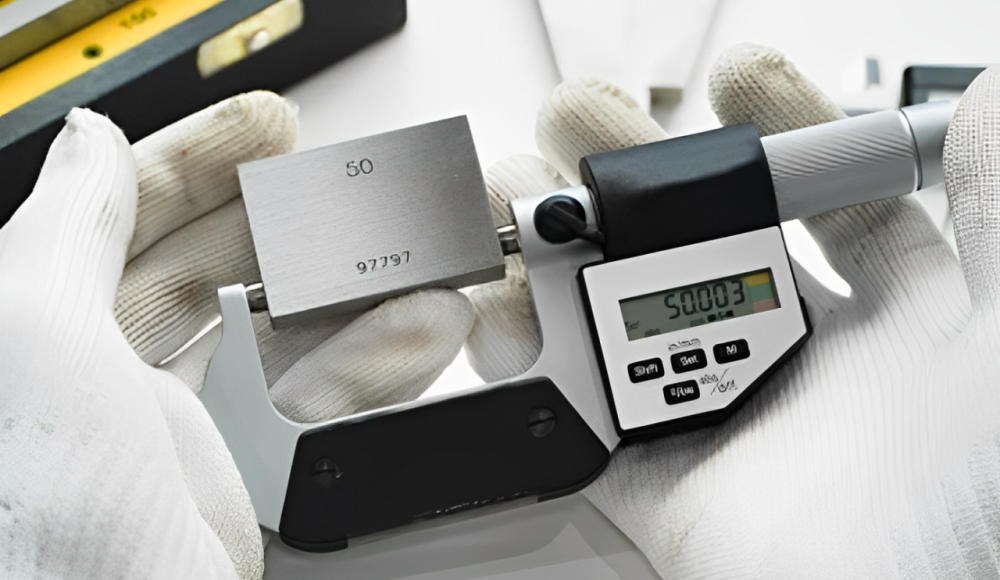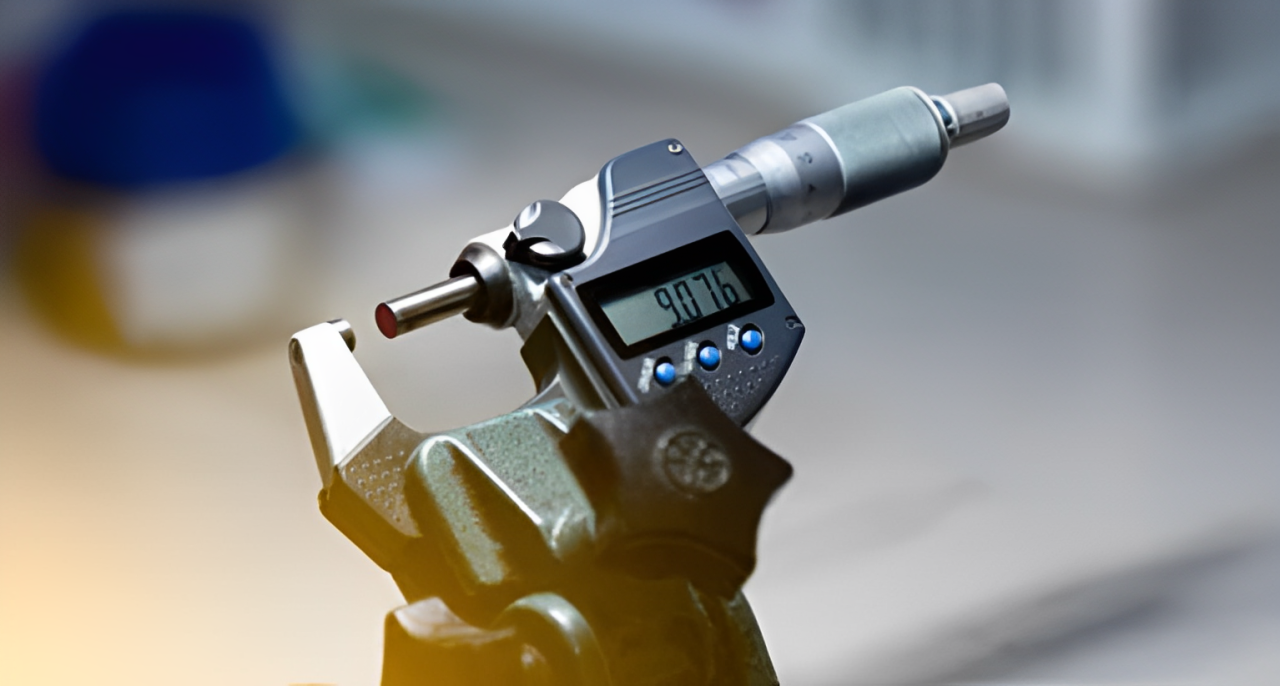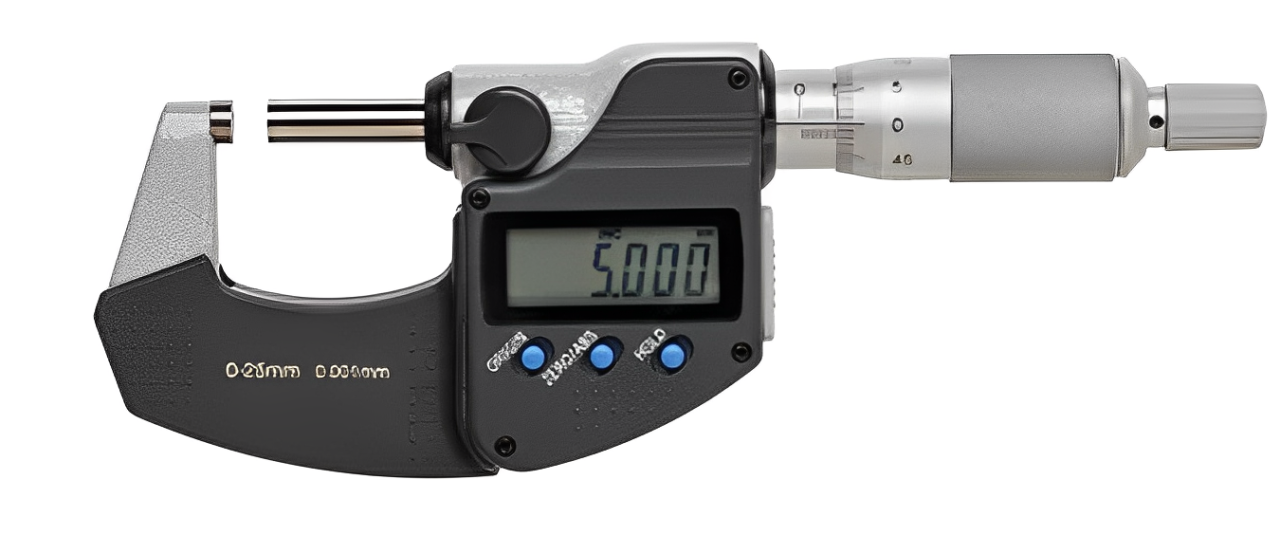Les micromètres sont indispensables dans les industries où il est nécessaire d'obtenir des dimensions exactes de pièces métalliques.. Un micromètre est un instrument de mesure utilisé dans les industries, c'est à dire. fabrication, usinage, et ingénierie pour mesurer les distances avec une grande sensibilité et une précision allant jusqu'à un millième de pouce ou même moins. En matière de qualité, ils sont utiles simplement parce que lorsque les mesures sont précises, toutes les pièces de toute structure mécanique sont bien adaptées pour un bon fonctionnement, qualité sans réserve. Dans cet article, vous apprendrez que le micromètre est fait de, comment ça fonctionne, et pourquoi il est utilisé pour produire des pièces précises.
Qu'est-ce qu'un micromètre?
Un micromètre est un outil de mesure précis qui permet de mesurer la distance et la dimension d'un objet relativement petit.. Son application la plus courante concerne les industries avec des niveaux de tolérance élevés., c'est à dire. la production d'articles d'ingénierie. Les micromètres sont généralement utilisés pour mesurer des dimensions avec une grande précision. mis-à-part, ils fournissent des résultats meilleurs que les millimètres standards. Cela fait du micromètre un outil important dans les zones de contrôle qualité afin que le fabricant s'assure que chaque pièce est fabriquée pour répondre aux normes nécessaires d'efficacité et de performance..
Que sont les pièces du micromètre?
Voici différentes pièces micrométriques:
- Cadre: Ceci est important pour offrir une plate-forme solide sur laquelle de telles mesures peuvent être prises et est essentiel pour toute configuration..
- Enclume: La norme par laquelle un objet particulier est défini, évalué, ou comparé.
- Broche: Transferts pour toucher l'objet pour connaître sa taille.
- Dé: Régule la position de la broche pour un mouvement fin avec des mesures sur la barre.
- Arrêt à cliquet: Applique des restrictions pour empêcher une évaluation invalide par les mesures créées.
- Contre-écrou: Aide à maintenir la broche dans une position fixe pour maintenir une bonne lecture.
Quel est le cœur du micromètre?
La partie active du micromètre est la vis de précision, à l'aide duquel le mouvement est extrêmement faible, si nécessaire pour mesurer les distances. Cette vis a des filetages avec de grandes graduations pour aider la broche à glisser plus près ou plus loin de l'enclume avec une grande délicatesse rendant le micromètre extrêmement précis.. C'est la qualité interne et l'étalonnage de cette vis qui permettent aux micromètres d'avoir une précision de mesure améliorée..
Quel est le principe de fonctionnement du micromètre?
Les micromètres sont basés sur le mouvement de la vis, la rotation du dé à coudre donne un mouvement linéaire à la broche. À chaque cycle de rotation du dé à coudre, la broche parcourt une petite distance fixe en fonction du pas des filetages de la vis.. De la même façon, les échelles sont marquées sur le bord intérieur du dé à coudre et sont choisies en fonction du type d'utilisation recherché, comme des fractions de millimètres, ou millièmes de pouce.
Comment utiliser correctement un micromètre
Voici quelques façons d’utiliser correctement un micromètre:
- Positionner l'objet: Pour mesurer n'importe quel objet, placez l'objet que vous souhaitez mesurer entre l'enclume (la partie immobile) et la broche (la partie mobile du micromètre).
- Ajuster la broche: Faites pivoter doucement le dé à coudre dans le sens des aiguilles d'une montre pour rapprocher la broche de la surface de l'objet et la rencontrer..
- Utilisez la butée à cliquet: Si votre micromètre a une butée à cliquet, faites-le pivoter pour le verrouiller, pour vous assurer que vous appliquez des niveaux de pression appropriés sans trop le verrouiller.
- Verrouiller la broche (Facultatif): S'il y a une offre contre-écrou, puis tournez-le dans le sens des aiguilles d'une montre pour verrouiller la broche afin de sécuriser la position mesurée.
- Prenez la lecture: Pour lire la mesure, suivez les étapes ci-dessus indiquées tout en utilisant le manchon et le dé à coudre..
- Manipuler avec soin: Parfois, il ne faut pas laisser tomber le micromètre ni l'exposer à des températures élevées ou basses inutiles, car cela fausserait la précision. Vous devez le nettoyer pour conserver une lecture précise la plupart du temps.
Étapes pour lire un micromètre
Donc, discutons des étapes de lecture d'un micromètre:
- Vérifiez l'échelle des manches: Lorsque vous vérifiez l'échelle principale sur la pochette, ce sont les unités entières. (en pouces ou en millimètres) ainsi que toute moitié indiquée.
- Lire l'échelle du dé à coudre: Placez la balance sur le dé à coudre rotatif et voyez quelle ligne arrive sur la ligne centrale de la manche.. Cela donne la seconde, une mesure à plus petite échelle une mesure supplémentaire (en millièmes de pouce ou en centième de millimètre par exemple).
- Combinez les mesures: Maintenant, amenez la lecture de l'échelle du manchon à la lecture de l'échelle du dé à coudre.. Cela vous donne à son tour la mesure finale.
Quelle pression peut être exercée lors de la mesure?
Cet instrument de mesure doit être touché doucement car il faut enfoncer le piston de lecture uniquement dans la mesure où l'objet souhaité s'y conforme.. Certains micromètres sont dotés d'une butée à cliquet intégrée qui rend l'application de la pression cohérente.. Son utilisation élimine également les effets de la force de l'utilisateur sur les mesures à prendre, ayant ainsi des lectures incorrectes..
Quand utilise-t-on un micromètre?
Chaque fois qu'il est nécessaire de mesurer avec une grande précision des points très proches les uns des autres, en particulier, dans la fabrication, fabrication d'ingénierie, usinage, et contrôle qualité, un micromètre est utilisé. Il est utilisé pour mesurer les épaisseurs, diamètre, et profondeur des parties étroites, principalement là où d'autres instruments de mesure ne peuvent pas fournir des approximations précises. Les micromètres sont généralement utilisés pour vérifier les mesures avec précision. Ils sont donc populaires là où des niveaux de tolérance serrés sont un facteur important..
Pourquoi un micromètre est-il important pour fabriquer des pièces de qualité?
Un micromètre est un autre outil précieux que tout ingénieur en mécanique doit utiliser pour obtenir des dimensions en raison des tolérances serrées requises pour produire des pièces de valeur présentant d'infimes différences.. En raison de son haut degré de précision, il élimine les risques d'erreurs, en particulier lorsque l'on travaille sur plusieurs composants d'un produit. La mesure de longueur à l'aide de micromètres joue un rôle essentiel dans l'assurance qualité pour plusieurs raisons, la plus importante étant, puisque l'outil permet de vérifier que les pièces respectent les tolérances nécessaires à la qualité, fiabilité, et niveaux de satisfaction client à atteindre. Cela rend le micromètre très important dans la fabrication et l'ingénierie de haut niveau..
Différence entre le micromètre et le pied à coulisse
| Fonctionnalité | Micromètre | Pied à coulisse |
| Précision | Une plus grande précision (jusqu'à 0.001 mm ou 0.0001 pouce) | Précision modérée (jusqu'à 0.02 mm ou 0.001 pouce) |
| Plage de mesure | Portée plus petite, idéal pour les petites dimensions | Une plus grande portée, adapté aux petits et grands objets |
| Types de mesures | Mesure principalement les dimensions extérieures | Mesures extérieures, intérieur, et dimensions de profondeur |
| Facilité d'utilisation | Nécessite plus de compétences pour lire | Plus facile à lire avec une échelle à vernier ou un affichage numérique |
| Application | Idéal pour les tâches de haute précision dans l'usinage et la fabrication | Polyvalent, utilisé pour les mesures à usage général |
| Coût | Généralement plus cher | Généralement plus abordable |
| Portabilité | Compact mais portée limitée | Plus polyvalent et souvent portable pour une variété de tâches |
| Durabilité | Très résistant, conçu pour une utilisation répétée avec de petites pièces | Durable mais peut être moins robuste dans les environnements de haute précision |
| Cas d'utilisation courant | Contrôle de qualité, ingénierie de précision | Usinage général, ingénierie, et travaux de réparation |
Pourquoi est-ce important pour former des machinistes qualifiés?
Le machiniste doit maîtriser l'utilisation des micromètres avec autant de facilité car cela lui permet d'apprendre la qualité de son travail lorsqu'il l'utilise pour mesurer.. L'utilisation efficace des micromètres aide les machinistes à usiner des tolérances étroites, ce qui est utile dans les industries où même un léger écart peut entraîner un non-fonctionnement ou un danger.. La formation avec des micromètres aide également l'apprenant à acquérir une appréciation de base des outils de mesure de base importants., surtout en c, travaux mécaniques complexes.
Remplacement du micromètre par mesure numérique?
Occasionnellement, les versions numériques des micromètres ou des pieds à coulisse peuvent constituer un bon substitut aux types ordinaires de micromètres étant donné qu'ils sont utilisés occasionnellement ou que l'utilisateur doit effectuer une lecture fréquemment ou facilement. Les outils numériques affichent les mesures à bout portant, minimisant ainsi les erreurs pouvant être commises lors de la tentative de lecture d'une balance.. Cependant, les micromètres de type analogique sont connus pour être plus précis et plus fiables pour les travaux complexes; par conséquent, les variétés numériques sont utilisées pour plus de commodité, même dans le travail de précision.
Avantages du micromètre
Voici quelques-uns des avantages de l’utilisation d’un micromètre:
- Haute précision: Des instruments à commande numérique d'une excellente précision sont utilisés dans les applications d'assurance qualité.
- Durabilité: Conçu spécifiquement pour un usage général et fabriqué à partir de matériaux solides pour résister au temps de test.
- Cohérence: Fournit des mesures cohérentes, produisant ainsi des valeurs crédibles.
- Facilité d'étalonnage: Il dispose d'un type de processus d'étalonnage très basique qui garantit qu'il continue à fournir des résultats précis..
- Applications spécialisées: Idéal pour mesurer des mesures de petites étendues particulières.
Limites du micromètre
- Convient aux petites dimensions, mais ne convient pas aux gros objets.
- Il est nécessaire pour lire et fonctionner à un taux d'efficacité spécifique.
- Les changements de température peuvent également poser un problème.
- Types de mesures qui ne conviennent pas à la détermination de formes irrégulières.
- Du côté négatif, l'outil coûte plus cher que les autres instruments de mesure.
Applications du micromètre
Voici quelques-unes des applications courantes des micromètres:
- Contrôle de qualité: Expérience dans la réalisation de contrôles légers pour vérifier que chaque pièce a été fabriquée selon les normes requises.
- Ingénierie de précision: Indispensable dans la fabrication de produits, surtout quand la précision est impérative.
- Usinage et travail des métaux: Enregistre les mesures des pièces avec précision.
- Étalonnage: Ceci est utilisé pour confirmer la fiabilité d’autres instruments de mesure.
- Recherche scientifique: Facilite les expériences qui s’aventureraient dans ce qui est mesurable selon des normes élevées.
Conclusion
En conclusion, le micromètre est généralement utilisé dans les industries de précision. De plus, il offre des mesures dimensionnelles très précises et cohérentes sur de petites dimensions.. Il présente certains inconvénients, notamment des effets sur la portée et la température., mais sa précision ne peut être ignorée car il s'agit d'un dispositif standard fondamental dans la production et l'ingénierie mécanique pour vérifier l'assurance qualité.. Plus loin, il a besoin de l'exigence la plus essentielle pour enseigner à des machinistes qualifiés des normes élevées de performance en production, est le micromètre. Contactez-nous pour plus d'informations.
FAQ
Qu'est-ce qui rend un micromètre si précis et précis?
L'utilisation d'un filetage évident dans un micromètre facilite la réalisation de très petits ajustements pour déterminer les mesures au millième de pouce ou de millimètre le plus proche..
Comment lire correctement un micromètre?
D'abord, lire la valeur donnée par l'échelle principale sur la pochette, mais en unités entières seulement. Après cela, lire le dé à coudre pour connaître les unités de mesure fractionnaires, le cas échéant, puis résumez toutes les unités en un seul nombre. Les deux évaluations doivent être résumées dans la mesure finale.
Est-il possible d'utiliser un micromètre au lieu d'un pied à coulisse?
Non, chaque outil a son utilité, et personne sensé n'utilisera deux outils pour le même travail. Les micromètres sont meilleurs pour les petites dimensions, tandis que les pieds à coulisse sont meilleurs pour la gamme et les différentes formes.
Lors de la mesure de la pression à appliquer?
Le toucher de la plume seul doit être appliqué pour éviter qu'il ne déplace accidentellement la position du fil.; certains micromètres sont équipés d'une butée à cliquet qui garantit qu'une pression aussi faible et uniforme est appliquée à chaque fois.
Comment entretenir un micromètre?
Il s'agit de caméras simples et d'apparence simple qui doivent être maintenues propres et sèches et idéalement rangées dans un étui de protection.. Ils doivent être calibrés souvent pour que le système renvoie des résultats précis en cas de besoin..
La précision augmente-t-elle avec l'utilisation d'un micromètre numérique?
Les modèles analogiques ont une précision comparable et sont légèrement plus difficiles à lire car ils ne sont pas nécessairement plus précis que leurs homologues numériques., micromètres numériques.
Comment calibrer un micromètre?
Une cale étalon standard sera utilisée pour ramener le micromètre à zéro et ensuite l'ajuster finement aux dimensions de la cale étalon..







